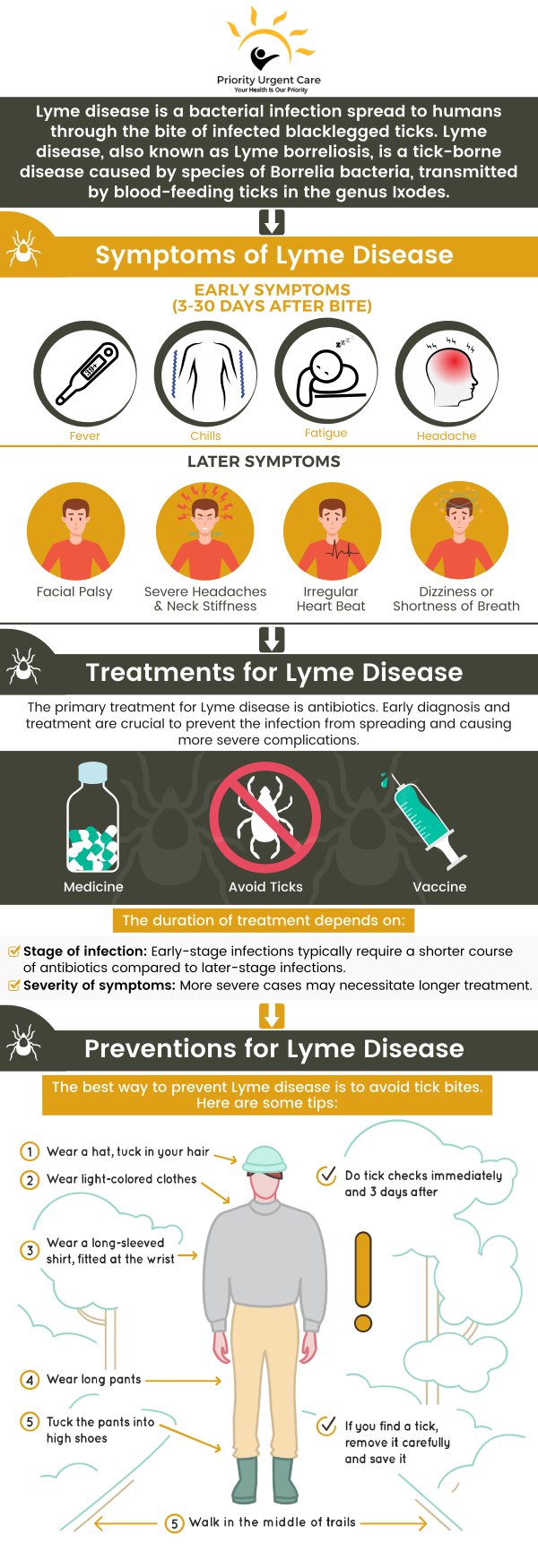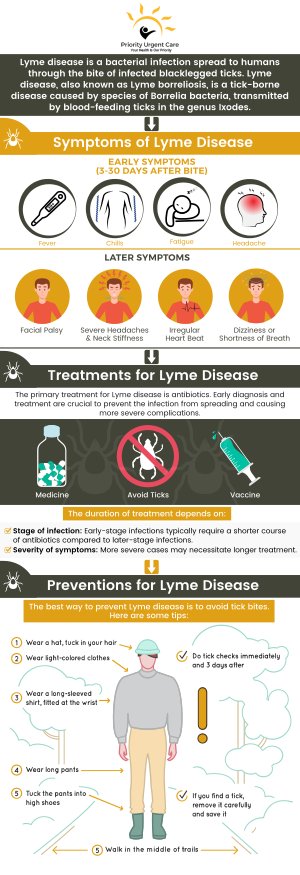Lyme Disease Treatment Clinic Q&A
Lyme disease is an infection you get from tick bites. The first symptom is usually a rash. Learn more about Lyme disease symptoms and the treatment options available. Get treatment for Lyme disease today at Priority Urgent Care and Walk-In Clinic. Contact us today or visit us online to book an appointment. We have convenient locations to serve you in Cromwell, CT, East Haven, CT, Ellington, CT, Newington, CT, Oxford, CT, Unionville, CT and Wallingford, CT.


Table of Contents:
What does Lyme disease do to a person?
What causes Lyme disease?
How serious is Lyme disease?
How do you know if you have Lyme disease?
What happens if you go untreated for chronic Lyme disease?
Lyme disease presents a variety of symptoms. Usually, they appear in stages, but they can overlap.
Early signs and symptoms include a small, red bump, similar to the bump of a mosquito bite, that appears after a tick bite or tick removal and resolves within a few days. The occurrence of this is not indicative of Lyme disease.
Some signs and symptoms may appear within a month of the infection. Three to 30 days after a tick bite, a red area may appear that sometimes clears in the clinic, resembling a bulls-eye pattern. The rash (erythema migrans) grows slowly over days and can spread to 12 inches. The area is usually not itchy or painful but might feel warm to the touch.
Lyme disease is characterized by erythema migrans, although not everyone with the disease experiences it. A person may develop this rash at more than one location on their body.
Aside from the rash, other symptoms include fever, chills, fatigue, body aches, headaches, neck stiffness, and swollen lymph nodes.
If left untreated, Lyme disease can cause more serious problems.
There are four main bacteria that cause Lyme disease. Borrelia burgdorferi and Borrelia mayonii cause Lyme disease in the United States, while Borrelia afzelii and Borrelia garinii cause the disease in Europe and Asia. Known as the deer tick, Lyme disease is the most common tick-borne illness in these regions. In fact, it is transmitted through the bite of an infected black-legged tick.
It’s more likely that you could get Lyme disease if you live or spend time in heavily wooded or grassy areas where ticks carry the disease. Whenever you are in an area where ticks are present, it’s important to take precautions.
The seriousness of Lyme disease varies, although it can sometimes be cause for concern. While the condition is not usually life-threatening it can cause long-term complications. For these reasons, it is important to seek a diagnosis as promptly as possible following initial exposure to reduce the seriousness of the condition.
Some people continue to experience symptoms such as fatigue, aches, and low energy after being diagnosed and treated for Lyme disease. Symptoms may be similar to fibromyalgia and chronic fatigue syndrome. Consult your doctor if your symptoms return or don’t improve after taking antibiotics.
Lyme disease is only caused by a minority of tick bites. It is more likely that you will contract the disease if the tick remains attached to your skin for a longer period of time. If the tick is attached for less than 36 to 48 hours, Lyme infection is unlikely.
If you think you’ve been bitten and are experiencing signs and symptoms of Lyme disease, call your doctor – particularly if you live in an area where Lyme disease is common. Early treatment of Lyme disease is more effective.
Untreated Lyme infection can lead to new signs and symptoms in weeks to months. A common example of this is erythema migrans. Other parts of your body may also be affected by the rash.
Your knees are especially likely to be affected by severe joint pain and swelling, but the pain can spread to any joint.
The inflammation of the membranes surrounding your brain (meningitis), temporary paralysis of one side of your face (Bell’s palsy), numbness and weakness in your limbs, and impaired muscle movement may occur weeks, months, or even years after infection. Reach out at Priority Urgent Care and Walk-In Clinic to learn about treatments for Lyme disease. We have convenient locations to serve you. For more information, please Call us or book an appointment online. Walk-ins are welcome! We serve patients from Ellington CT, Unionville CT, East Haven CT, Cromwell CT, Oxford CT, Newington CT, East Windsor CT, Somers CT, Burlington CT, Canton CT, Branford CT, New Haven CT, Middletown CT, Rocky Hill CT Seymour CT, Middlebury CT, Hartford CT, Wallingford, CT, Addison CT, and BEYOND!

Additional Services You May Need
▸ Urgent Care
▸ DOT Physicals
▸ Worker’s Injury Treatment
▸ Drug Testing
▸ Physical Exams
▸ School/Sports Physicals
▸ Sports Injury Treatment
▸ X-Ray Services
▸ Pediatric Urgent Care
▸ Poison Ivy
▸ STD Testing
▸ Immunizations & Vaccinations
▸ Lab Testing
▸ Pre-Employment Physical
▸ Employer Services


